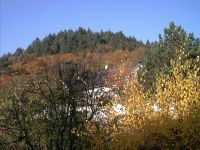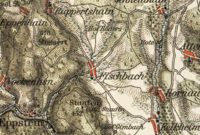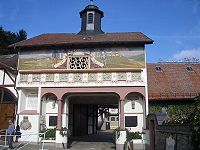.gif)
Fischbach (Taunus)
Encyclopedia

Kelkheim
Kelkheim is a town in the Main-Taunus-Kreis district in Hesse, Germany. Situated in the Taunus mountains, Kelkheim is noted for its attractive scenery. Kelkheim is situated approximately 10 km west of Frankfurt. Wiesbaden, the main capital of Hesse, is about 25 km from Kelkheim. Mainz,...
, Main-Taunus district of Germany
Germany
Germany , officially the Federal Republic of Germany , is a federal parliamentary republic in Europe. The country consists of 16 states while the capital and largest city is Berlin. Germany covers an area of 357,021 km2 and has a largely temperate seasonal climate...
and is situated at the western border of Frankfurt am Main in the Taunus
Taunus
The Taunus is a low mountain range in Hesse, Germany that composes part of the Rhenish Slate Mountains. It is bounded by the river valleys of Rhine, Main and Lahn. On the opposite side of the Rhine, the mountains are continued by the Hunsrück...
mountain range. Fischbach is a middle-class town and has about 5,900 inhabitants.
Location

Eppstein
Eppstein is a town in the Main-Taunus-Kreis, in Hesse, Germany.-Geographical situation:Eppstein lies west of Frankfurt am Main, around 12 km north east of the state capital Wiesbaden, and is at the edge of the Taunus mountains....
in the west and Königstein im Taunus
Königstein im Taunus
Königstein im Taunus is a climatic spa and lies on the thickly wooded slopes of the Taunus in Hesse, Germany. Owing to its advantageous location for both scenery and transport on the edge of the Frankfurt Rhine Main Region, Königstein is a favourite residential town...
in the northeast.
The eponymous creek has its source below Ruppertshain, flows through Fischbach and the tight Fischbachtal (fish creek valley), until the creek reaches the Schwarzbach (black creek) in Eppstein. Fischbach is surrounded of three mountains, Fischbacher Kopf, Staufen and Rossert.
Despite of the idyllic location, Fischbach is mainly a suburb of Frankfurt Rhein-Main Region.
Traffic
Bundesstraße 455Bundesstraße 455
Bundesstraße 455 is a German Bundesstraße in the federal state of Hesse. The route runs southwest from Schotten in Vogelsbergkreis to Mainz-Kastel, a borough of the Hessian capital city of Wiesbaden....
(federal highway 455) heads from Königstein via Fischbach to Eppstein and Wiesbaden
Wiesbaden
Wiesbaden is a city in southwest Germany and the capital of the federal state of Hesse. It has about 275,400 inhabitants, plus approximately 10,000 United States citizens...
. The former through road was substituted by a bypass in the early 1980s. The new road does not bypass Fischbach but crosses the town on an artificial embankment which destroyed the meadows of the creek. The town center at Langstraße is crossed by a bridge. Three bus routes connect Fischbach with Frankfurt Transit system - mainly Kelkheim railway station.
Structure of the town
The old town center is situated at the intersection of the main roads Kelkheim–Ruppertshain and Königstein–Eppstein. The first road, Langstraße, is the main road of the old part of the village. The town was protected by the creek and a trench.In the 19th century Fischbach grew along both streets, especially Kelkheimer Straße and Eppsteiner Straße.
After World War II
World War II
World War II, or the Second World War , was a global conflict lasting from 1939 to 1945, involving most of the world's nations—including all of the great powers—eventually forming two opposing military alliances: the Allies and the Axis...
, Fischbach grew due to settlements of refugees. Street names like Egerländer Straße and Königsberger Straße reminded old homes of new Fischbach residents. The residential areas were built, on both sides of Kelkheimer Straße and on the south-side of the town, around Staufenstraße and Sodener Straße. In the north, only a small residential estate was built on a former brickyard area (An der Ziegelei).
Out of the village at the street to Königstein, summer cottages were built in the 70s. Nowadays people are living there all the time.
Administrative history
Fischbach was founded by FranksFranks
The Franks were a confederation of Germanic tribes first attested in the third century AD as living north and east of the Lower Rhine River. From the third to fifth centuries some Franks raided Roman territory while other Franks joined the Roman troops in Gaul. Only the Salian Franks formed a...
. The first document which proves the existence of Fischbach (gift to Fulda
Fulda
Fulda is a city in Hesse, Germany; it is located on the river Fulda and is the administrative seat of the Fulda district .- Early Middle Ages :...
convent), is dated in the year 780. In the 8th and 9th century imperial laws appear. In 813, the village was in possession of Earl Liutfried as royal feud. Starting from 890 Fischbach was part of the shire of Uualahes and during early
Early Middle Ages
The Early Middle Ages was the period of European history lasting from the 5th century to approximately 1000. The Early Middle Ages followed the decline of the Western Roman Empire and preceded the High Middle Ages...
and high middle ages
High Middle Ages
The High Middle Ages was the period of European history around the 11th, 12th, and 13th centuries . The High Middle Ages were preceded by the Early Middle Ages and followed by the Late Middle Ages, which by convention end around 1500....
a member of the Niddagau province.
In 1348 the Lords of Eppstein became the new rulers. In 1581 Fischbach became part of Archbishopric of Mainz
Archbishopric of Mainz
The Archbishopric of Mainz or Electorate of Mainz was an influential ecclesiastic and secular prince-bishopric in the Holy Roman Empire between 780–82 and 1802. In the Roman Catholic Church hierarchy, the Archbishop of Mainz was the primas Germaniae, the substitute of the Pope north of the Alps...
and was governed from Königstein. After Napoleon split the Holy Roman Empire in 1806, Fischbach and the vicinity was part of Duchy of Nassau. Nassau was annexed by Prussia
Prussia
Prussia was a German kingdom and historic state originating out of the Duchy of Prussia and the Margraviate of Brandenburg. For centuries, the House of Hohenzollern ruled Prussia, successfully expanding its size by way of an unusually well-organized and effective army. Prussia shaped the history...
in 1866 degraded to Wiesbaden district of the Prussian province Hessen-Nassau. Fischbach attended to this administration till the foundation of Hesse
Hesse
Hesse or Hessia is both a cultural region of Germany and the name of an individual German state.* The cultural region of Hesse includes both the State of Hesse and the area known as Rhenish Hesse in the neighbouring Rhineland-Palatinate state...
in 1946.
After being integrated to Prussia, Fischbach belonged to the Upper-Taunus district. Since 1928 it was part of the newly founded Main-Taunus district. In 1977 Fischbach was incorporated to the city of Kelkheim, together with the former community Rossert (Ruppertshain and Eppenhain).
Coat of arms

Economical and social history

Höchst (Frankfurt am Main)
Höchst is a district of Frankfurt am Main, Germany. It is part of the Ortsbezirk West, and is subdivided into 4 Stadtbezirke.Höchst am Main became part of Frankfurt am Main in 1928 together with its boroughs Sindlingen, Unterliederbach and Zeilsheim. It is situated 10 km west of downtown...
(Hoechst AG
Hoechst AG
Hoechst AG was a German chemicals then life-sciences company that became Aventis Deutschland after its merger with France's Rhône-Poulenc S.A. in 1999...
, today Industriepark Höchst), is a source of income since the late 19th century. The opening of railway line from Königstein to Höchst in 1901 improved the connections to Höchst and Frankfurt. Before that, many workers had to walk every morning to Soden railway station (approx. 8 km (5 mi)).
After World War II
World War II
World War II, or the Second World War , was a global conflict lasting from 1939 to 1945, involving most of the world's nations—including all of the great powers—eventually forming two opposing military alliances: the Allies and the Axis...
, Fischbach had about 1,000 inhabitants. Due to refugee settlement, mainly from Sudetenland
Sudetenland
Sudetenland is the German name used in English in the first half of the 20th century for the northern, southwest and western regions of Czechoslovakia inhabited mostly by ethnic Germans, specifically the border areas of Bohemia, Moravia, and those parts of Silesia being within Czechoslovakia.The...
, the number of residents was doubled. The village became even bigger in the 60s and 70s due to suburbanization
Suburbanization
Suburbanization a term used to describe the growth of areas on the fringes of major cities. It is one of the many causes of the increase in urban sprawl. Many residents of metropolitan regions work within the central urban area, choosing instead to live in satellite communities called suburbs...
. Fischbach changed from a small Taunus-village to a suburb of Frankfurt. The number of residents rose to about 6,000 in the early 80s and is not changing a lot since that time.
Due to strong immigration of citizens from Frankfurt, the confessional (mainly catholic
Catholic
The word catholic comes from the Greek phrase , meaning "on the whole," "according to the whole" or "in general", and is a combination of the Greek words meaning "about" and meaning "whole"...
in former times) and the social structure changed: in addition to the long-established village residents, mostly craftsmen and farmers, an academic affected middle-class appeared (employees of Hoechst AG)
Church Saint Trinity
In 1781, church Saint Trinity substituted an older church which was built in 1686. The building contains some extravaganza of this time and provides an impressive view from the lower meadows nearby. The church contains the so called “Roteltisstein”, a Christian tombstone from the 7th century. It was transferred to Fischbach in 1868 from a demolished pilgrim chapel nearby (Gimbach). The stone proves the early Christianisation in this region.Church Saint John
Like everywhere in the former area of Archbishopric of Mainz, inhabitants of Fischbach were traditionally catholic. The result of the large number of Protestants immigrated after World War II, was a growing demand for a Protestant church. A community was founded in the 60s and is named after John the BaptistJohn the Baptist
John the Baptist was an itinerant preacher and a major religious figure mentioned in the Canonical gospels. He is described in the Gospel of Luke as a relative of Jesus, who led a movement of baptism at the Jordan River...
. The church has a modern style and has big, coloured windows.
Rettershof

Premonstratensian
The Order of Canons Regular of Prémontré, also known as the Premonstratensians, the Norbertines, or in Britain and Ireland as the White Canons , are a Catholic religious order of canons regular founded at Prémontré near Laon in 1120 by Saint Norbert, who later became Archbishop of Magdeburg...
convent. During the protestant reformation
Protestant Reformation
The Protestant Reformation was a 16th-century split within Western Christianity initiated by Martin Luther, John Calvin and other early Protestants. The efforts of the self-described "reformers", who objected to the doctrines, rituals and ecclesiastical structure of the Roman Catholic Church, led...
, the land lord closed the convent in 1559 and converted it to a manor. The church of the convent was destroyed during the Thirty Years war. In 1884 an English man bought the manor and built a new mansion in Tudor Style architecture
Tudor style architecture
The Tudor architectural style is the final development of medieval architecture during the Tudor period and even beyond, for conservative college patrons...
. His successors built a restaurant in 1938, which offered products of the manor. The city of Kelkheim bought Rettershof in 1980 and renovated it.
Today, Rettershof consists of three parts: the historically styled yard of the manor, the former mansion and the restaurant. Nearby is a horse-riding range.
In the 80s, the mansion was the European headquarters of Hare Krishna
International Society for Krishna Consciousness
The International Society for Krishna Consciousness , known colloquially as the Hare Krishna movement, is a Gaudiya Vaishnava religious organization. It was founded in 1966 in New York City by A.C. Bhaktivedanta Swami Prabhupada...
-sect for a short time. Today it has been extended to a high-priced hotel.
Gimbacher Hof
Though Hofgut Gimbach can only reached by car via Kelkheim, it belongs to Fischbach. The way from Fischbach to Gimbacher Hof is only for pedestrians and bikes. The way leads through a protected landscape with fruit grasslands.Until 1868, Gimbach was the location of a pilgrim chapel. After their demolition, the altar was transferred to Saint Trinity in Fischbach, but the „Gimbach pilgrimage“ exists even today.
The name is derived from three small creeks, which join together as Gimbach close to the manor. The first document which proves the existence is dated in the year 1287 as "Gynnenbach".
The manor runs horse breeding; ciders press (Apfelwein
Apfelwein
Cider in Germany is called Apfelwein , as the German language has not used the word cider. It is also regionally known as ebbelwoi, äppler, stöffsche, apfelmost , viez , and saurer most . It has an alcohol content of 5.5%–7% and a tart, sour taste...
) and a campground as well as a popular restaurant which offers self-made Apfelwein.
Hanseklingerbrunnen
The bronze fountain in the village center was created in 1987 by Johannes Norbert Klarmann. It shows a craftsman, who drinks water from the fountain.Hanseklinger is a nickname for residents of Fischbach. The derivation of the term has not been clarified.
Bürgerhaus
The town hall of Fischbach was established shortly before the village was incorporated to Kelkheim. Today the building is community center, contains outposts of Kelkheim city authorities and is home for several clubs. The functional architecture is typical for buildings of the 70s. Fire brigade facilities are also located at the town hall square.Albert-von-Reinach school
Albert-von Reinach-school is an elementary school. It is located above the town hall square and consists of two buildings. The catchments area is equivalent to Fischbach area. The school is named after Albert von Reinach (* November 7, 1842 in Frankfurt am Main; † January 12, 1905). He was a banker from Frankfurt, who built a villa nearby the village. Albert von Reinach supported the school with noble donations. The older building was erected in 1952/54, the newer one in 1967. The complex replaced the old school building near St. Trinity church, which was placed there at least since 1822 and demolished in 1967. The first school in Fischbach was documented in 1604.Staufen school / Eichendorff school
Staufenschule (5th – 10th form) had been a comprehensive school for children from Fischbach, Hornau, Ruppertshain and Eppenhain. For several years, it was a secondary school too. The building is also built in 70s architecture style. Since July 31, 2006, it is part of Kelkheims’ Eichendorff schoolStaufenhalle
After a long planning-period, a new sports hall opened its gates in 2002. The “Staufenhalle” replaced an old version from 1971. The hall is the largest roofed room in Kelkheim. It has a small tribune and is used by the upper mentioned schools as well as by several sports clubs and for events of regional interest.Sports field
Open air sports events take place on Fischbach sports field. It’s located on a border of a wood in the west-end of the village. It is mainly used for football matches of the local football club SV Fischbach and was opened on May 31, 1930. In 1952 the area was modified. The ground had been rotated by 90 degrees, changing rooms were built. The sports field reopened on August 2, 1953. In 1982 the facilities were renovated and a house for club activities was built. The sports field was equipped with an artificial turf during summer 2008.Events
The biggest event starts in February or March: Fischbach is a stronghold of carnivalCarnival
Carnaval is a festive season which occurs immediately before Lent; the main events are usually during February. Carnaval typically involves a public celebration or parade combining some elements of a circus, mask and public street party...
in the Rhine-Main-area. The Carnival Monday parade attracts over 25,000 visitors every year.
The Kermesse
Kermesse
Kermesse or kermis, is a Dutch language term derived from 'kerk' and 'mis' that became borrowed in English and French, originally denoting the mass said on the anniversary of the foundation of a church and in honour of the patron...
(Kerb) in fall has only local meaning. The Kermesse is celebrated on town hall square. The fire brigade, which is also located there, has to move all vehicles to another place during this time.
The Protestant church community celebrates Saint John’s day (June 24).
The Hanseklinger festival in late summer is celebrated in the village center around the homonymous fountain.

